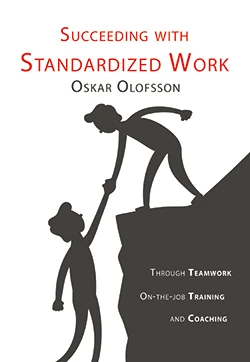
Today I will introduce an effective method of working for improvement.
In contrast to the new method, most companies are today working according to some of the following techniques:
Risk analysis: An effective and preventing tool. The analyses are most useful in processes where we cannot tolerate mistakes, for example, production of pharmaceuticals or for running a nuclear power plant. The problem with risk analyzes is that they are intense and result in relatively few improvements compared to the effort put into them.
Project-based improvement initiatives: Call them Kaizen events, Six Sigma project or something else. These actions often only work when you focus on one thing at a time as they require a big amount of resources. Other sectors of the company may be forgotten and given to low priority when you focus on your chosen problem only.
Improvement groups where “everyone” is included: This is fun at first, and you get a lot of new ideas. Sadly the commitment usually decreases quickly. The reason is that the staff has their ordinary work to do and no one has the time to implement the changes. The new ideas often take ages actually to be put to the test.
Fix the problems as they come or “Why fix something that isn’t broken?”: The problem is that the environment changes all the time. If you don’t adjust your processes, they will always stop working.
Let me suggest a more effective way of doing improvement work as a complement to the methods mentioned above. My method consists of a few simple steps:
1. Everybody is trained and tries to follow a standardized work
2. When this is not possible for whatever reason, a team leader is called upon
3. Team leaders initiate problem-solving that he/she leads him/herself together with team members or get help from support staff
4. The problem is mapped out
5. Action is taken
6. The process is tested out, and the result analyzed
7. When the need arises, the process is repeated from step 4 until the problem is solved
According to my method, the employees take responsibility for noticing and reporting problems while the team leaders/managers initiate the problem solving following a simple but scientific method.
If you according to this method only make one improvement at a time, you get the possibility of learning and understanding the process. The problems do not return since you have understood the initial cause.
Now imagine that you do one improvement every week. Then you will improve four things in a month. Is that not fast enough? Why not perform and evaluate one improvement a day, or maybe even one in the morning and one in the evening? This way every process can be improved in small steps all of the time without for that matter being drowned in work.
Okay, I admit it, my method may not be new. According to Wikipedia, it is called the scientific method and was introduced by Francis Bacon in 1620.
By Oskar Olofsson

Making lean work for you

World-Class / Lean Manufacturing

5S Implementation

SMED Quick Change-over

TPM and Plant Maintenance

Succeeding With Standardized Work

Succeeding With 5S